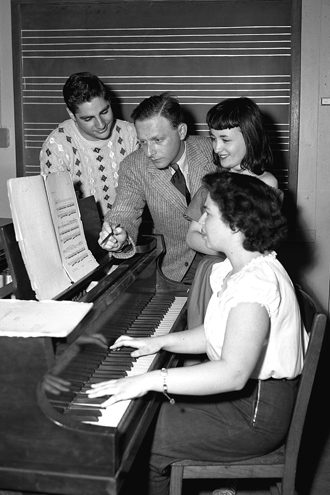Boston concert to celebrate Irving Fine’s centennial
Five feisty works by Fine and friends: "Boston School" colleagues Harold Shapero and Arthur Berger

Irving Fine instructing students
The evening, which will include a free pre-concert talk at 7 pm, will pay tribute to Fine as well as Harold Shapero and Arthur Berger, three central figures of the mid–century Boston musical landscape. This trio of lifelong friends and composers advanced a unique vision for American music that incorporated the neoclassicism of Stravinsky, the clean elegance of Copland, and the edginess of serialism, all with a highly personal stamp.
Tickets are available for $20-40, $15 for students. To receive 50 percent off the ticket price, use the code FINE2014 when purchasing the ticket at bmop.org. Tickets also can be purchased by calling or visiting Jordan Hall Box Office, 617-585-1260, or at tix.com.
“Many of Fine’s pieces have become standard repertory works representing the American neoclassical school,” explains Gil Rose, artistic director and conductor of BMOP, the nation’s premier orchestra dedicated exclusively to commissioning, performing, and recording new orchestral music. “Although his roots are firmly grounded in Boston, he played a leading role in America’s music history.”
Fine experimented with many styles throughout his career: serialism, 18th-century forms, and romantic expressivity among them. Yet Stravinsky’s neoclassical style was an early and lasting influence on Fine as well as fellow Harvard classmates and Brandeis faculty members Shapero and Berger. In the 1940s, the three became associated with a group of primarily Jewish, Boston-based composers alternately known as the “Stravinsky School,” “Boston School,” “Harvard Stravinskians,” and “Boston Neoclassicists.” Fine wrote that the music of Stravinsky in which he and his peers grounded themselves was inclined to be “diatonic and tonal or quasi modal…an ideal balance between form and emotion…peppered with unresolved neighbor dissonant tones, all of it tastefully set forth through his genius for spacing and texture.”
BMOP illuminates Fine’s remarkable gift for lyricism in a performance of three pieces written during the composer’s final years. Capping the program is Fine’s last and most ambitious work – the dramatic Symphony (1962), which he conducted with the Boston Symphony Orchestra prior to his untimely death later that year. Considered to be the most substantial work of his career, it stands as Fine’s creative masterpiece. The Symphony illustrates the culmination of a unique, diverse aesthetic, demonstrating the composer’s subtle grasp of not only neoclassicism and serialism, but polyphony, rhythmic force, and symphonic form.
During his 12 years on the Brandeis faculty, Fine played many roles, including founder and chair of the School of the Creative Arts. Fine was responsible for bringing leading artists to the faculty (Leonard Bernstein and Aaron Copland) and cutting-edge new works (by the likes of Miles Davis, Merce Cunningham and Marc Blitzstein) to the campus. Fine’s time as an educator, mentor, administrator, and composer transformed Brandeis into an internationally-recognized breeding ground for emerging talent that would define American culture in the 20th century. One of Fine’s most popular works from the Brandeis years is the three-minute marching song, "Blue-White.ʺ The orchestral version, Blue Towers (1959), is dedicated to Brandeis and then president Abram Sachar. The title references the Brandeis school colors and a campus architectural landmark, Usen Castle, known for its three distinctive towers. Prior to arriving at Brandeis, Fine served on the music faculty at Harvard. He was a key member of the composition faculty at Tanglewood in the early years under Serge Koussevitzky.
Rounding out the Fine tribute is a BMOP performance of his four Diversions for Orchestra (1959). Dedicated to Fine’s three daughters (Claudia, Emily and Joanna) and French poodle, Koko, this playful yet sophisticated piece premiered at a 1960 Boston Symphony Orchestra children’s concert.
Harold Shapero (1920-2013) joined the Brandeis faculty in 1951 and spent 37 years teaching in the Department of Music. He helped develop the university’s renowned electronic music studio and taught theory and composition. His works are emotionally intense and expertly structured, hailed for their rhythmic vitality, elegance, and memorable thematic material. BMOP presents one of his finest gems, Serenade in D for string orchestra (1946). Shapero continued to embrace an unambiguously neoclassical style throughout his career, and the Serenade demonstrates the composer at his peak.
Completing the triumvirate is the celebrated composer and music critic Arthur Berger (1912-2003). Berger joined the Brandeis faculty in 1953, retiring in 1980 as the Irving Fine Professor of Music Emeritus. BMOP has long been a Berger champion. In 2002, it recorded Arthur Berger: The Complete Orchestral Music (New World Records) followed by the 2013 release of Arthur Berger: Words for Music, Perhaps (BMOP/sound).
Like Fine, Berger immersed himself in Stravinskian neo-classicism early in his career, later expanding his technique to achieve a unique synthesis with 12‑tone serialism. BMOP performs his Prelude, Aria, and Waltz for String Orchestra (1982), a revision of his previous work Three Pieces for String Orchestra of 1945. The orchestral version premiered in 1985 in Cambridge, Mass., with John Harbison conducting.
Categories: Arts





